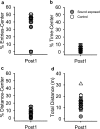Behavioral Animal Model of the Emotional Response to Tinnitus and Hearing Loss
- PMID: 29047013
- PMCID: PMC5783924
- DOI: 10.1007/s10162-017-0642-8
Behavioral Animal Model of the Emotional Response to Tinnitus and Hearing Loss
Abstract
Increased prevalence of emotional distress is associated with tinnitus and hearing loss. The underlying mechanisms of the negative emotional response to tinnitus and hearing loss remain poorly understood, and it is challenging to disentangle the emotional consequences of hearing loss from those specific to tinnitus in listeners experiencing both. We addressed these questions in laboratory rats using three common rodent anxiety screening assays: elevated plus maze, open field test, and social interaction test. Open arm activity in the elevated plus maze decreased substantially after one trial in controls, indicating its limited utility for comparing pre- and post-treatment behavior. Open field exploration and social interaction behavior were consistent across multiple sessions in control animals. Individual sound-exposed and salicylate-treated rats showed a range of phenotypes in the open field, including reduced entries into the center in some subjects and reduced locomotion overall. In rats screened for tinnitus, less locomotion was associated with higher tinnitus scores. In salicylate-treated animals, locomotion was correlated with age. Sound-exposed and salicylate-treated rats also showed reduced social interaction. These results suggest that open field exploratory activity is a selective measure for identifying tinnitus distress in individual animals, whereas social interaction reflects the general effects of hearing loss. This animal model will facilitate future studies of the structural and functional changes in the brain pathways underlying emotional distress associated with hearing dysfunction, as well as development of novel interventions to ameliorate or prevent negative emotional responses.
Keywords: anxiety; depression; distress; hearing loss; salicylate; sound exposure; tinnitus.
Conflict of interest statement
The authors declare that they have no conflicts of interest.
Figures






Similar articles
-
Tinnitus and hyperacusis: Contributions of paraflocculus, reticular formation and stress.Hear Res. 2017 Jun;349:208-222. doi: 10.1016/j.heares.2017.03.005. Epub 2017 Mar 7. Hear Res. 2017. PMID: 28286099 Free PMC article.
-
Anxiety-like behavior induced by salicylate depends on age and can be prevented by a single dose of 5-MeO-DMT.Exp Neurol. 2020 Apr;326:113175. doi: 10.1016/j.expneurol.2020.113175. Epub 2020 Jan 8. Exp Neurol. 2020. PMID: 31923390
-
A behavioral paradigm to judge acute sodium salicylate-induced sound experience in rats: a new approach for an animal model on tinnitus.Hear Res. 2003 Jun;180(1-2):39-50. doi: 10.1016/s0378-5955(03)00075-3. Hear Res. 2003. PMID: 12782351
-
Animal models of tinnitus.Hear Res. 2016 Aug;338:88-97. doi: 10.1016/j.heares.2015.10.011. Hear Res. 2016. PMID: 26520585 Review.
-
Hearing loss, hyperacusis, or tinnitus: what is modeled in animal research?Hear Res. 2013 Jan;295:140-9. doi: 10.1016/j.heares.2012.01.005. Epub 2012 Feb 7. Hear Res. 2013. PMID: 22330978 Review.
Cited by
-
Reporting Data on Auditory Brainstem Responses (ABR) in Rats: Recommendations Based on Review of Experimental Protocols and Literature.Brain Sci. 2021 Nov 30;11(12):1596. doi: 10.3390/brainsci11121596. Brain Sci. 2021. PMID: 34942898 Free PMC article.
-
Altered synaptic plasticity of the longitudinal dentate gyrus network in noise-induced anxiety.iScience. 2022 May 6;25(6):104364. doi: 10.1016/j.isci.2022.104364. eCollection 2022 Jun 17. iScience. 2022. PMID: 35620435 Free PMC article.
-
Central Compensation in Auditory Brainstem after Damaging Noise Exposure.eNeuro. 2018 Aug 17;5(4):ENEURO.0250-18.2018. doi: 10.1523/ENEURO.0250-18.2018. eCollection 2018 Jul-Aug. eNeuro. 2018. PMID: 30123822 Free PMC article.
-
Limiting Hearing Loss in Transgenic Mouse Models.eNeuro. 2025 Feb 27;12(2):ENEURO.0465-24.2025. doi: 10.1523/ENEURO.0465-24.2025. Print 2025 Feb. eNeuro. 2025. PMID: 39900508 Free PMC article.
-
Universal Recommendations on Planning and Performing the Auditory Brainstem Responses (ABR) with a Focus on Mice and Rats.Audiol Res. 2023 Jun 2;13(3):441-458. doi: 10.3390/audiolres13030039. Audiol Res. 2023. PMID: 37366685 Free PMC article.
References
Publication types
MeSH terms
Substances
Grants and funding
LinkOut - more resources
Full Text Sources
Other Literature Sources
Medical

